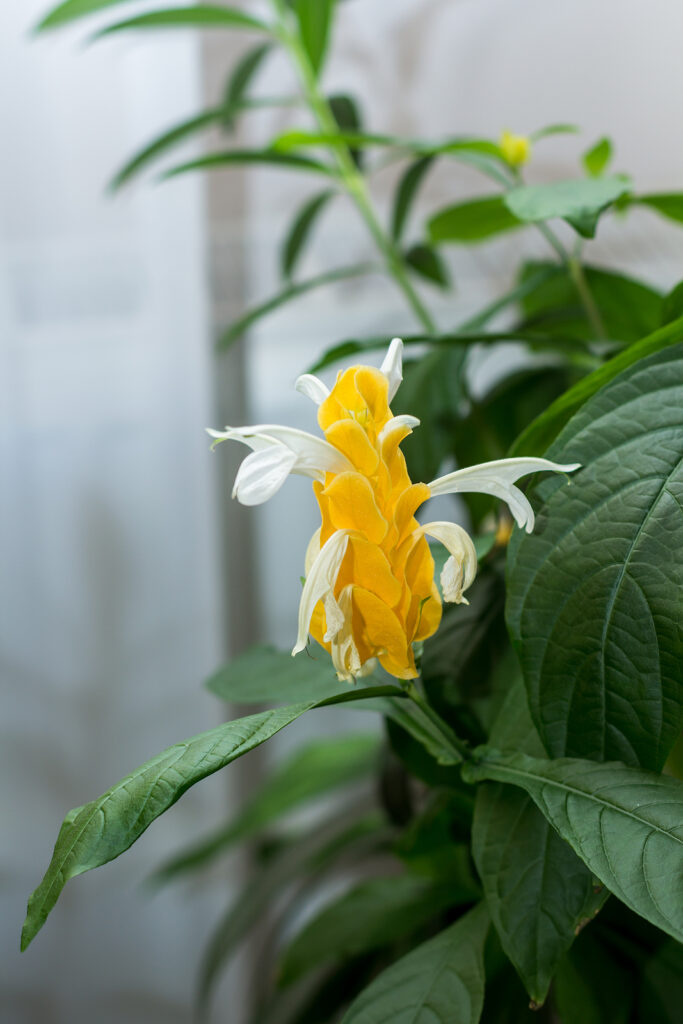Pachystachys is a tropical evergreen perennial that is grown for its tubular, 2-lipped flowers that are borne in erect terminal spikes with large, overlapping, usually brightly colored bracts.
Pachystachys flowers can be scarlet or white; bracts can be pale green or bright golden yellow. Flower spikes are 4 to 6 inches (10-15cm) long. Leaves are ovate to lance-shaped and mid-to dark green.
In tropical regions, Pachystachys is a colorful addition to a border. Where temperatures fall below 50°F (10°C) grow Pachystachys as a houseplant.
Pachystachys is a genus of 12 species of evergreen perennials and shrubs native to tropical woodlands in the West Indies and Central and South America.
Get to know Pachystachys
- Plant type: Tropical evergreen perennial
- Growing zones and range: Zones 11-15
- Hardiness: Half-hardy to tender; where temperatures fall below 50°F (10°C) grow Pachystachys as a houseplant
- Height and width: 3 to 6 feet (1-2m) tall, 18 to 36 inches (45-90cm) wide
- Foliage: Simple, ovate to lance-shaped mid- to dark green leaves
- Flowers: Tubular, 2-lipped flowers borne in erect, terminal spikes with large overalapping bracts
- Bloom time: Spring, summer
- Uses: Border plant, houseplant
- Common name: Lollipop plant, Cardinal’s guard
- Botanical name: Pachystachys
- Family name: Acanthaceae
- Origin: Woodlands from West indies and tropical Central and South America

Where to plant Pachystachys
- Light outdoors: Plant Pachystachys in full sun.
- Light indoors: Plant in full light with high humidity.
- Soil outdoors: Grow Pachystachys in fertile, moist, well-drained soil.
- soil indoors: Grow in a soil-based potting mix.
When to plant Pachystachys
- Set container-grown Pachystachys outdoors in spring.
Planting and spacing Pachystachys
- Space Pachystachys 18 to 36 inches (45-90cm) apart.
How to water and feed Pachystachys
- Water Pachystachys freeling during the growing period.
- Fertilize Pachystachys with a balanced liquid fertilizr monthly.
Pachystachys care
- Where temperatures fall below 50°F (10°C) grow Pachystachys as a houseplant.
Growing Pachystachys as a houseplant
- Grow Pachystachys in a warm room with bright light and high humidity.
- The growing medium should be soilless and well drained.
- Water to keep the medium evenly moist at all time.
- Fetilize monthly during the growing and flowering period.
Pachystachys pests and diseases
- Whiteflies, spider mites, leaf spot, and root rot may occur.
Pachystachys propagation
- Root softwood cuttings with bottom heat in summer.
Pachystachys varieties to grow
- Pachystachys coccinea, Cardinal’s guard. Erect shrub, sparsely branched, ovate strongly viened dark green leaves to 8 inches long; tubular , 2-lipped scarlet flowers are borne in terminal spikes to 6 inches long.
- P. lutea, lollipop plant. Grows to 12 inches tall indoors; leaves are oval, 5 inches long and dark green with depressed veins; flower spike is 4 inches long; flowers are white, 2 inches long and open goledn yellow.



